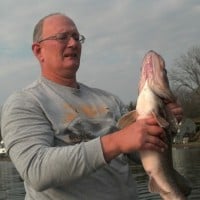 Every spring at the combined urgings of increasing day length and warm water temps, walleye try to spawn. Research has shown that the walleye will make do with whatever spawning habitat that is available in their area including flooded grasses. But the ideal environment for natural reproduction are sections of river or lake bottoms that have fields of golf ball to baseball sized rocks with gravel where the female walleye can lay her eggs.
Every spring at the combined urgings of increasing day length and warm water temps, walleye try to spawn. Research has shown that the walleye will make do with whatever spawning habitat that is available in their area including flooded grasses. But the ideal environment for natural reproduction are sections of river or lake bottoms that have fields of golf ball to baseball sized rocks with gravel where the female walleye can lay her eggs.
Survival of the fittest
Life is a struggle before it begins, and it doesn’t get any easier after the egg hatches. If you knew the odds of any given egg living to become a keeper in the traditional line of thinking, you would marvel at every two pound walleye you ever caught. The chances of that egg growing up to be a trophy walleye, say a ten pounder, would test the capacity of the calculator you use to balance your check book !!
Each spawning walleye, depending on size, deposits between 60,000 to 250,000 eggs, averaging about 85,000 eggs per fish. Of those eggs, 5 to 20% hatch, so in most cases hatching success is less than 10 percent.
Once the eggs hatch, and make it to their first summer, they are then called fingerlings. The success rate to get to this stage is .7 percent. Fingerlings will experience a mortality rate of about 50 percent –again assuming good feeding and habitat conditions – each year, until reaching catchable size of 1 ¾ to 2 pounds.
Here are some numbers to look at:
• You can figure to wind up with about 125 keeper fish out of about 1 million eggs
• If you have your sights set on a 10 pounder as a trophy, using the 50 percent mortality rate, optimistically you might find 2 fish out of the 1 million eggs
Now how do you feel about that 2 pound walleye you just caught? So please use common sense and use selective harvest. The more adult females that are swimming the better chance we all have to catch that trophy walleye of 10 pounds or better!!
Information from this article comes from Mark Strand’s book, Walleye Tactics, Tips and Tales.


